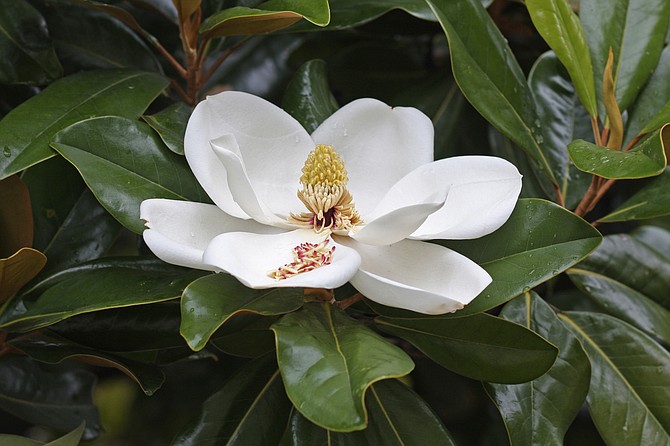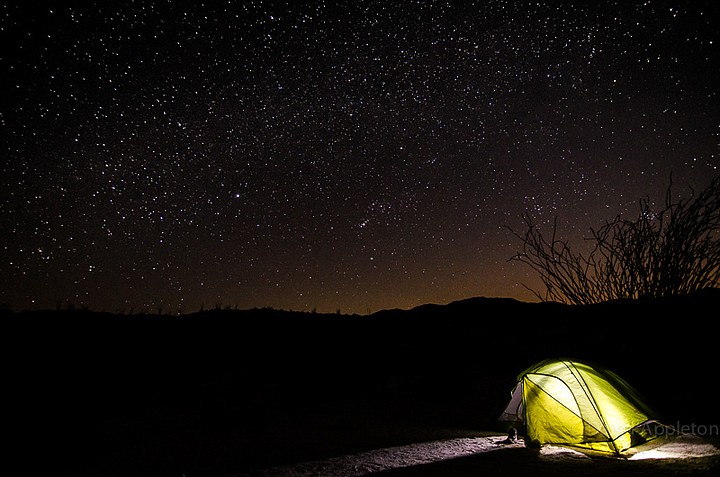 Facebook
Facebook
 X
X
 Instagram
Instagram
 TikTok
TikTok
 Youtube
Youtube

Magnolia, the Southern U.S. native commonly planted as a decorative street tree in many of San Diego’s older neighborhoods, continues to bloom this month. Called the “queen of the flowering broadleaf evergreens,” its branches support leathery, dark-green leaves and large, white blossoms of pleasing fragrance.
The Heat of Summer will most likely reach its feverish peak in inland San Diego County during the coming month — July. (Coastal San Diego is different: since its weather is greatly affected by the slowly warming mass of ocean water adjacent to it, coastal temperatures usually peak in August or September.) The weather station at Borrego Springs commonly measures midsummer highs in the 110s Fahrenheit (the record high is 120.3 degrees, a reading set on June 27, 1990), but certain locales in the low-lying, barren basins of Anza-Borrego Desert State Park — notably the Borrego and Carrizo badlands — probably experience even higher temperatures.

Overnight camping in the desert in summer is relatively carefree. Little or no shelter is needed and early morning temperatures are delightfully tepid. Daytime is another story. Prospective explorers of the desert in summer should take along enormous quantities of water and inform a responsible person of their whereabouts.

July’s Lowest Tides are for early risers only! Check out the local tide-pool life without hordes of other people around. Monday, July 3, features a minus 1.71 foot tide at 4:28 am. Tuesday, July 4, brings a minus 1.8 foot tide at 5:13 am. Wednesday, June 5, you can roll out of bed at a “reasonable” hour to catch the minus 1.67 foot tide at 5:58 am.


Magnolia, the Southern U.S. native commonly planted as a decorative street tree in many of San Diego’s older neighborhoods, continues to bloom this month. Called the “queen of the flowering broadleaf evergreens,” its branches support leathery, dark-green leaves and large, white blossoms of pleasing fragrance.
The Heat of Summer will most likely reach its feverish peak in inland San Diego County during the coming month — July. (Coastal San Diego is different: since its weather is greatly affected by the slowly warming mass of ocean water adjacent to it, coastal temperatures usually peak in August or September.) The weather station at Borrego Springs commonly measures midsummer highs in the 110s Fahrenheit (the record high is 120.3 degrees, a reading set on June 27, 1990), but certain locales in the low-lying, barren basins of Anza-Borrego Desert State Park — notably the Borrego and Carrizo badlands — probably experience even higher temperatures.

Overnight camping in the desert in summer is relatively carefree. Little or no shelter is needed and early morning temperatures are delightfully tepid. Daytime is another story. Prospective explorers of the desert in summer should take along enormous quantities of water and inform a responsible person of their whereabouts.

July’s Lowest Tides are for early risers only! Check out the local tide-pool life without hordes of other people around. Monday, July 3, features a minus 1.71 foot tide at 4:28 am. Tuesday, July 4, brings a minus 1.8 foot tide at 5:13 am. Wednesday, June 5, you can roll out of bed at a “reasonable” hour to catch the minus 1.67 foot tide at 5:58 am.
Comments